Search: Bag Hit Then Attack From Ruck
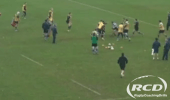 1:03
1:03
Fringe Attack - Pop and Ruck
Attacking close around the fringe can minimise risk of losing the ball and can help turn slow ball into quick ball, putting the defence on the back-foot.
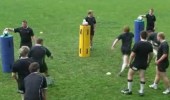 0:25
0:25
Tackle bag drill one hit & support
support has to read whch bag is being tackled and get to be in support by reading the situation
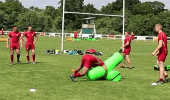 4:55
4:55
Ruck Clearing Exercises
Two crucial clearance techniques - the saddle roll, and the duck and clean. It's important for players to practice these at length, under pressure, under fatigue, and with an element of decision-making in order to best re-create a match situation.
To watch over 2500+ videos join now for free!
JOIN NOWMaul and Ruck - Clearing the Ruck
Clearing the tackle area with pace relies on committed support. Clearance rucking is a dynamic method of restarting the attack if the defence has managed to create a breakdown.
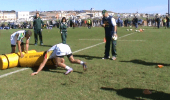 2:06
2:06
Breakdown - Accurate Rucking
This series of clips shows how conditioning and good technique are crucial to be effective at the breakdown. The progressions are simple and the key coaching points are Low to high body position Strong leg drive Accuracy on the target - The tackle bag
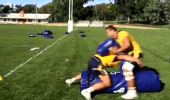 8:10
8:10
Ruck Clearing and Decision Making
Advanced clearing exercises for senior players. The support player makes a decision on how to clear out the ruck based on the position of the opposition.
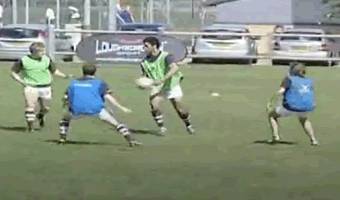 4:30
4:30
Small-side game - Ruck Touch
There are many versions of ruck touch with the support players needing to recognise the needs of the tackled player.
The defence should be conditioned to provide increasing pressure to the tackle area. This will develop the situation recognision of the attacking players who must play accordingly. Robotics in rucking regardles of the situation should be discouraged and the option of picking upthe ball and going forward should be an option
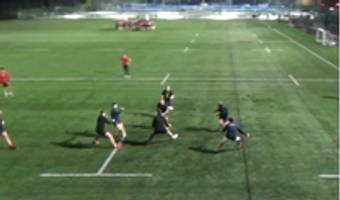 1:28
1:28
Attack vs Defence Continuous Drill 4V2
The attackers work to beat the defence, setting up a 'tip' (running a hard line) and 'pull back' option. They should read the defensive movements and make a decision to hit the tip option or pull out the back.
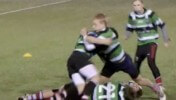 3:31
3:31
Ruck touch - Focus on rolling players away
A key technique at the breakdown is the ability to roll players away, this applies when your opponent already has a good body position over the ball. Danny Wild from Leeds carnegie uses a game and breakout sessions to deliver his session
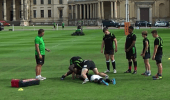 5:51
5:51
Turning defence into attack
The Northampton saints approach to defence is to "Turn over ball" and to this end the tackle is only the start of the process and the coach outlines this approach and provides some examples
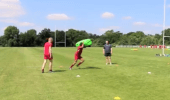 4:17
4:17
Technical Fitness with Tackle Bags
Tackle bags are a great tool to use in your conditioning sessions. The reduced impact allows players to peform high repititions of contact technique under fatigue, with low risk of injury.
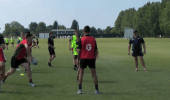 6:36
6:36
Attacking lines and late shifting
This clip demonstrates the skills and movements required to fix and beat defenders. Using a combination of passing accuracy and physical agility can significantly improve your attacking options. The coach uses questions to help the players learn
Maul and Ruck - Spin Maul
The spinning or rolling maul is an effective weapon when executed at speed. Notice what happens to the pace of the attack when the ball goes to floor with a breakdown
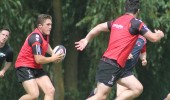 2:15
2:15
Quick fire Attacking Game
This is a great game to keep players engaged by constantly testing their decision-making and execution in attack. Essentially, it's a 4 v 2 game where the attackers always have the advtantage, but they still have to make good decisions to score. It is a high-tempo game that requires the attackers to turn around and attack again straight after scoring.
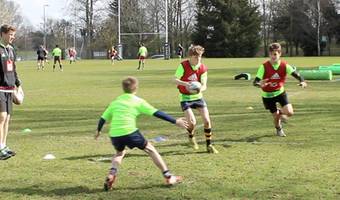 3:21
3:21
Identify Attacking Options
A few drills that will help the attackers identify space in attack and work on how to exploit it!
Complimentary Attack
Complimentary Attack
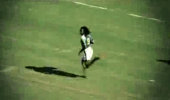 5:19
5:19
Sevens - Uncovered - Attack
Elite coaches discuss their attacking philosophies and this underpines the skills and techniques they will work on as coaches and the type of trainign sessions they will plan. As a coach how do you coach the skills that the Fijian players possess or the patience the Welsh side had to win the last 7's world cup. Does the team represent the ideas and plans of the coach?
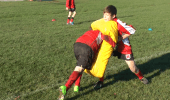 0:59
0:59
Tackle Technique - Down/Up and hit shield
Originally a rugby league practise this exercise is used for players to gain confidence in contact with both contact shields and the ground. Body position is important as is leg drive and the speed of hitting the ground and getting back up again. You can do this in lines and use it for fitness
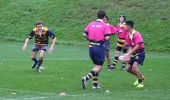 4:18
4:18
Attacking Lines: Unders and Overs
Using different angles of running confuses tacklers and pulls a defensive unit out of line. Learning the skills to both run these lines and pass the ball accurately is key to any ambitious team looking to attack and offload
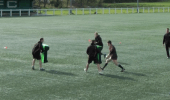 4:04
4:04
Developing running lines to attack
A series of progressions to develop how players attack when "Coming round the corner" from phase play
 1:00
1:00
Mike Catt - Attacking from Lineouts - Back Ball
Classroom session with Mike Catt - discussing the key points of attacking from a lineout
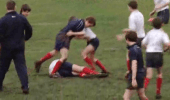 2:17
2:17
Ruck Touch Rugby
Coaches can use games to introduce all skills for your age group. If you are very specific about the conditions you apply then players will learn these skills in a fun and enjoyable game
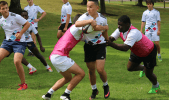 4:43
4:43
Rucking - Live With 5
A clever and competitive practise using 5 players that involves passing, tackling and then making the crucial decision of what to do at the breakdown. This can be done from Under 12's upwards
Maul and Ruck - Under 13s and 14s Ruck
Training through traditional drills does not develop game understanding and players often become robotic in their behaviour
Conditioned games promote game understanding and encourage players to recognise the needs at any given situation
The drill should be used only to refine technique and the danger is to develop players that act without game understanding
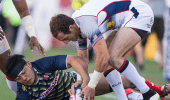 2:18
2:18
USA Sevens - Learn The Rules Of The Ruck
With less players the breakdown is much cleaner in Seven's and knowing the laws and being accurate in your skills wins matches. Mike Friday clarifies what can be a complex area and why many coaches focus on this facet of the game
L2 - Identifying Space to Attack
Skill Practice Description • Attacking team face away from defenders before play commences. • Attackers spread or grouped in any formation. • Defenders split (unseen by attack) between pitch A & B. • Coach calls “turn” and introduces the ball to the attack who turn to scan the distribution of the defence and attack whichever pitch they choose. • Defenders on the pitch not being attacked cannot cross over to help defend. • If the attack breaks down, the defence gain bonus point. • If attackers choose to attack the area with the most defenders and still score - gain a bonus point. • Progression: • Allow the defenders in the area not being attacked to move across to support the other defence. Perhaps make the secondary defence go deeper around a cone. • Vary the space before game starts between attack and defence - more or less time for the attackers. • Allow defence to recover the ball to counter attack. Key Coaching Points • Reward close and immediate support of the ball carrier in and around contact area. • Defenders deny space and time to the numerically superior attack
L2 - Attacking a Drift, Blitz and Cover Defence
Skill Practice Description • Within a game of touch the coach can at any breakdown - call blitz, drift and the defenders must run and touch the appropriate line. • The coach may also give players numbers in order to call specific defenders to leave the defence line which will create the need for defence to realign quickly. • Attackers must face the other way and attack when the ball is rolled from behind them. • On the coach’s call, the attack turn and the closest attacker picks up the ball and plays. • This ensures the coach can vary each player’s role and make the defence react. • Coach can then develop game by giving a visual clue to the defenders thus making the attackers react to an unexpected type of defence. Key Coaching Points • Visual Acuity-Looking for space. • Spatial awareness. • Highlighting defensive systems and attacking them appropriately. • Decision making. Relevance to the Game • This game is excellent for visual acuity and attacking differing defensive alignments. • Spaces are created by the leaving defenders, which the attackers have to identify
Back Play - Attack From Line Out - Older Youth
To take advantage of the forwards being grouped and to utilize the space this provides, the appropriate strike call needs to be made and space attacked
It’s not a matter of going through the strike move repertoire. It is about specific selection from the repertoire in order to attack identified areas of the opposition and game situations
Attacking the space between the two teams is paramount and attacking the ball when running a support line will assist the offload and turn defenders
QBE - Ruck Touch
3. Ruck Touch
Back Play - Attack From Scrum - Older Youth
It’s not a matter of going through a strike move repertoire. It is more about specific selection from the repertoire in order to attack identified targets according to the opposition and game situation
Attacking the space between the two teams is paramount and attacking the ball when running a support line will assist the offload and turn defenders
L2 - Back Line Attack from Set Piece
Skill Practice Description • The objective of this game is to score from first phase. • The defence start on the try line and can only advance to the five metre line (gain line). • The attack must start from the 5 metre line if simulating a scrum and vary the starting points i.e. centre field. • If simulating a lineout start, use the 10 metre line to half way. • If the attack can score from the set piece they are awarded five points. • If they score after one phase they are awarded four points. • If they score after two phases they get awarded three points and so on. • If the attack fails to score after four phases they turn around and defend. • Kicking options may be introduced. • Five attacks each team. Key Coaching Points • Appropriate passing (short, long, flat, deep etc.) • Appropriate running lines; decoy / option / creating spaces / accelerating into space. • Support and reaction. • Look-Think -Do Process • Allow the players to self correct before intervention from the coach Relevance to the Game • Accuracy in decision making scanning and decoy / option running lines
L2 - Attacking a Condensed Defence
Skill Practice Description • Two teams play normal touch rules. • 5 touch turnover. • When a touch is made, the game pauses and all defenders need to close in and place a hand on the shoulder of another defender. So all the defenders are bunched and in contact with each other. • The coach calls ‘play’ and the attack restarts. • The progression may be to leave one defender out of the bunch, which may provide a different challenge to the attack. • Then leave two defenders out of the bunch and slowly release the conditions to see if the attack can consistently identify opportunities to outflank or penetrate the defence. Key Coaching Points • Peripheral vision and general awareness. • Intuitive decision making. • Communication • Support and team work. Relevance to the Game • This game is designed to challenge the observation and decision making ability of the attack. • For the defence, it challenges the ability to cover quickly with both drift and sweeping defenders
Back Play from Set Piece - Attack from Line Out
To take advantage of the forwards being grouped and to utilize the space this provides, the appropriate strike call needs to be made and space attached.
Attacking the space between the two teams is paramount and attacking the ball when running support lines will assist the offload and turn defenders.
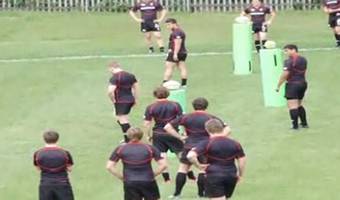 2:53
2:53
L2 - Conditioning Circuit
Using the full length of the pitch the practice is a continuous 3 v 2 scenario. • 3 attackers knock over a bag to collect a ball and attack 2 defenders in the 5m channel. • If they fail to beat the defenders (touch/grip), the attackers run back to knock over another bag and start again. • Having beaten the first defenders they carry on with the same ball to beat 2 further defenders who may choose a colour and start from the appropriate cone. • If the attackers fail to beat the defence they run back to the bag and start again with another ball. The defence can choose another colour to start from. • The next challenge is two free roaming defenders. If the attack fail they go back and knock over another bag to start again. • Finally the defenders choose a colour to start from and if the attack fail they get another ball and the defence choose another starting colour. • The objective is to complete the attack with the starting ball and restarts. Keep score to create competition
Back Play from Set Piece - Attack from Scrum
It’s not a matter of going through the strike move repertoire. It is about selecting appropriately from the repertoire according to the opposition and game situation.
Attacking the space between the two teams is paramount and attacking the ball when running support lines will assist the offload and turn defenders.
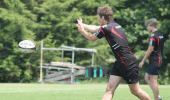 4:17
4:17
Attacking Ability at 13
Outside centres who have great attacking awareness and distribution skills are integral to teams who like to exploit quick ball by going wide. If these players are only able to run hard lines, then there are going to be missed opportunities out wide. Here, we highlight some great passing and attack play in the Premiership, as well as some ideas for you to use with your players.
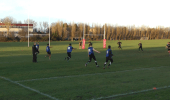 0:59
0:59
Broncos 6 - Attack to Defence 8 v 5
A combination of skills are tested, both technical and tactical with the defenders moving from a passing activity to defending 8 attackers. The coach can change the attack with different starting points and number of attackers
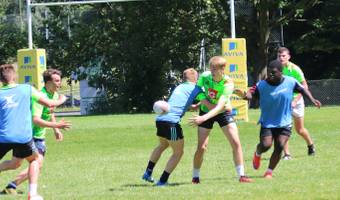 2:27
2:27
Small-side game - Overload Attack
The attacking team always has two or three extra players and the attack need to make best use of this numerical advantage. The coach can put three players in a different colour and they swap teams after each score to remain in the attack.
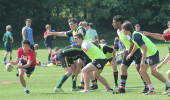 1:29
1:29
Saints - Attacking Basics
Northampton Saints coaches look at the basic principles of attack including holding depth and scanning the defensive situation.
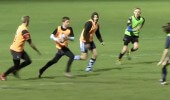 5:23
5:23
Passing and Attacking Lines
Northampton Saints Academy coaches introduce a conditioned exercise to help develop attacking skills.
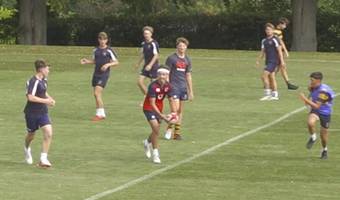 3:39
3:39
Overload Attack Game
This game allows your attack to experiment whilst working on communication, reloading for depth and handling skills. With an attacking overload this will also work on your defence communication and organisation in phase play.
QBE - Attacking a Drift, Blitz and Cover Defence
QBE - Attacking a Drift, Blitz and Cover Defence
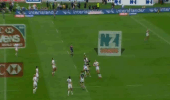 0:28
0:28
Sevens - Standard restart with attack winning ball 3
A well organised re start with one main attacker challenging for the ball with support both in front and behind him, if the ball is knocked either side of the main catcher the ball will be gathered by his teammates. Great leg drive to continue the attack and a very long pass to complete the scoring. Key factors : Accurate kick - Focus on the ball - Sideways jump - Catch ball above head - Structured support
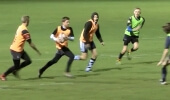 2:09
2:09
Attacking Fundamentals
If you're looking to build on your young players' ability to attack, we have loads of relevant ideas and examples. Here's a quick look. To see the full session, log in and go to the Northampton Saints page - 'Passing and Attacking Lines'
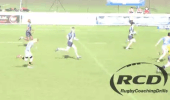 0:50
0:50
Stretch attack from re-start
Filton College claim the re-start and move the ball wide attack the space and stretch the defence. After recycling the ball quickly, they attack wide in the other direction where a 3 v 1 has been created.
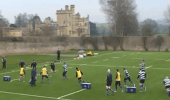 1:00
1:00
Attack and Re-align
Players are required to continually attack the gain-line, and re-align after each effort. They should try to use their inventory of attacking methods, not randomly, but to control the defence to eventually create gaps to exploit.
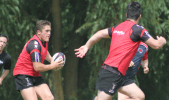 1:10
1:10
Three pass attack game
This exercise works on both attack & defence. The defenders have to cover the breakdown first and then work a drift defence while the attackers have to create space by fixing the first three defenders
Maul and Ruck - U9 Coaching
Notice how these players do not naturally set up rucks. Both teams try to keep the ball away from breakdown situations.
What would these games look like if the coaches stepped in and insisted on rucking?
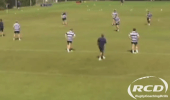 0:51
0:51
Attacking progression's 4 v 3
A progression from 3 v 2s, this drill is closer to a game situation, where there are more decisions for the attacking players to make. The gaps could appear in a variety of locations and they have several passing /running options. With 4 attacking players, you may wish to utilise your basic strike moves.
 0:54
0:54
Attacking progression's 5 v 4
Progressing from 3 v 2s an 4 v 3s, you can now attack with something resembling a full back-line. Give the defence different instructions each time to test the reactions and decision-making skills of your attacking players.
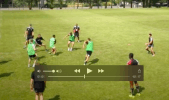 2:06
2:06
Attack Grid For All Ages
Progress your passing practises to make them competitive by adding defenders and ore chaos. This attack grid has lots of flexibility and can be used with players of all ages
Back Play - Attack From Scrum - Younger Youth
To take advantage of the forwards being grouped and to utilize the space this provides, young players should be encouraged to develop their decision making from a non-prescriptive environment.
It’s not a matter of going through a strike move repertoire. Its a matter of attacking the space between the two teams and running support lines that will assist the ball carrier
 5:01
5:01
360 Games - Any Direction Attack
A warm up or starting 360 game where players can attack in any direction. This game is the basis to for coaches to then add numerous conditions based upon the focus of the session
 0:59
0:59
Broncos 7 - T-shape Attack
Broncos 7 - T-shape Attack
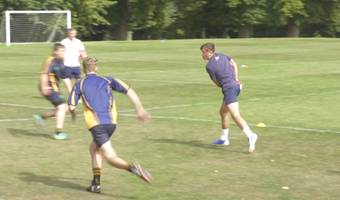 3:23
3:23
Attacking Shape - 4v1v1v1
This is the start of a series of progressions that takes you through how to set up your attacking shape through multiple lines of defence.
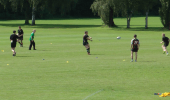 1:31
1:31
Turnover ball - Attacking from flat
This quick practice runs through how to attack straight from a turnover.
14. Attacking Waves Game
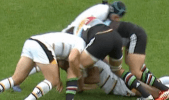 5:56
5:56
Bouncing - The key to contact skills
Encouraging players to improve their "Floor" skills is the key to improving contact skills such as tackling, rucking and competing for the ball. It might be simple but it is effective
QBE - Identifying Space to Attack
 2:22
2:22
Restart Attack
Here are some examples of good use of the restart in attack to help you in your coaching process
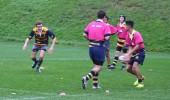 1:47
1:47
Running Lines in Attack
Modern defensive lines are well-organised and hard to break. It depends on the quality execution of attacking fundamentals. A good introduction is 'unders' and 'overs' running lines. Log in to see the full session.
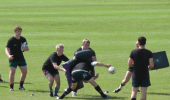 0:52
0:52
Attack from turnover
Attacking play from a turnover
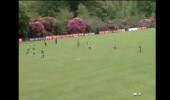
Lions 09 Attack plays 2
A clip on attacking options from the 2009 Lions
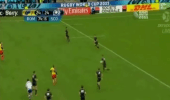 0:29
0:29
Men's - Counter Attack Plays
Not all kicks work out succesfully, in this clip the defenders turn a poor kick into a great counter attack
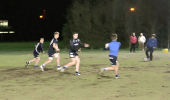 4:00
4:00
Attacking with simple systems
Sale Sharks full-back Rob Miller takes junior academy players through some attacking systems and highlights some of the key points to improve accuracy.
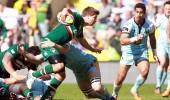 1:07
1:07
Ben Youngs Feature - Energy in Attack
Ben Youngs is a great example of a player who adds energy and pace to an attack through his efforts to produce quick ball for his backline, and his ability to catch defences off-guard. Log in to see coaching ideas from Leicester Tigers and other Aviva Premiership Rugby clubs.
 0:49
0:49
Mike Catt - Attacking from Lineouts - Dummy Options
Classroom session with Mike Catt - discussing the key points of attacking from a lineout
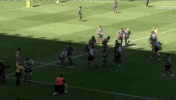 4:16
4:16
Lineout Attack
Here are some good examples of how to use the line out effectively in attack to help you in your coaching process
 1:03
1:03
Mike Catt - Attacking from Lineouts - Quick Ball
Classroom session with Mike Catt - discussing the key points of attacking from a lineout
 0:33
0:33
Junior - Counter attack plays
Junior - Counter attack plays
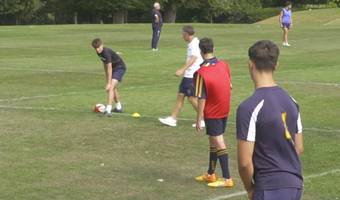 2:20
2:20
Attacking Shape - 4v2v2
While progressing your attacking shape be sure to include this exercise. With 2 waves of defence its crucial that your players learn to reload into a great shape in position.
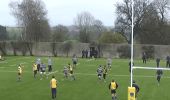 1:00
1:00
Attack Grid - 4 v 2
This continuous exercise puts pressure on your players to think fast and be ruthless in attacking the space. Coaches can change the size of the grid and the number of defenders to make it an easier game
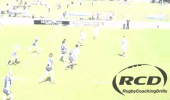 0:35
0:35
Counter-attack
After gaining a turnover, Filton College move the ball quickly in a counter-attack to secure a try.
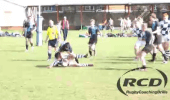 1:00
1:00
Support - Turnover and Counter-Attack
Support play is essential to rugby, particularly in sevens where there is more space. This clip sums up the importance of support. The Eastbourne College scrum-half is isolated and turned-over. Eton then counter-attack and, despite the best efforts of a single Eastbourne defender, they are able to secure the try thanks to an offload to a support runner.
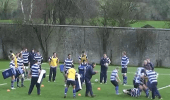 1:00
1:00
Rucking Zone
A tiring exercise of continuous rucking. Encourage your players to maintain good standards even when tiring and highlight the importance of getting straight up after one breakdown to make another.
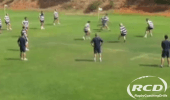 1:19
1:19
3 v 2 attacking practice
A useful drill to build decision-making skills. Attackers must choose from a variety of running and passing options.
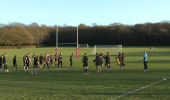 2:02
2:02
Broncos 3 - Develop waves of attack
The first wave of attackers identify space and punch through the first line of defence. The ball carrier looks to move the ball quickly and away from covering defenders. This exercise tries to copy game situations as players cover their team mates in defence
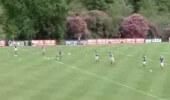 0:23
0:23
British lions - support & attack drill 1
This drill illustrates how attack can go from narrow channels to wide play very quickly, and players should practice this continually
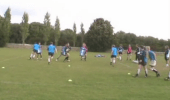 1:18
1:18
Diamond shape attack
Bath academy players practice the shape and lines of running for a "Diamond shape" attack system. The waves of players provide a number of different options
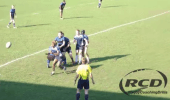 0:34
0:34
Attack from short lineout
With the dummy lifting pod moving back, Filton College execute a short lineout to the front lifter. They attack wide before 're-winding' and using the overlap on the nearside to break through for a try.
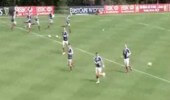 0:23
0:23
Lions 09 - Support & Attack
The ability to create attacking situations quickly is fundamental to creating pressure
Attacking narrow channel
A good exercise for scanning defenders and creating space for your co attackers
Maul and Ruck - Maul Gain Lines
With the maul, the gain line is fluid and the defence can be forced onto the back foot
With the ruck, the gain line is static and the defence are often set and on the front foot
Maul and Ruck - Under 10s and 11s Mauling
Notice how the tackled player often remains on their feet and a mass of pulling and pushing begins
When a player is taken to the ground, the supporting players try to pick the ball up. There is not a natural inclination to ruck
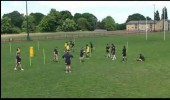 0:31
0:31
3v2 varied attack options
Developing decision making processes is essential to developing gamesense - in this drill we can vary the attack and defence to accelerate learning
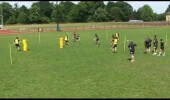 0:54
0:54
Change the point of attack - 4 v 3
This drill allows you to develop decision making by varying the attack and defence continually thus accelerating learning
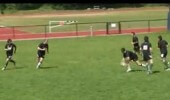 0:13
0:13
Attacking in waves of 3
The ability to realign quickly is important to developing the back play and counter attacking. Coaches can vary the numbers and timing of the first pass to make this exercise easier or more demanding. Key factors : Run straight - Comunicate early - Uniform distance and depth - Catch & pass in one movement - Hips straight - Hands & armes across the body - Realign quickly - Aerobic fitness
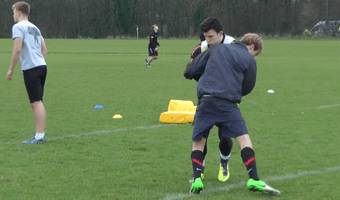 3:01
3:01
Continuity in Attack - Contact
Continuity in Attack - Contact
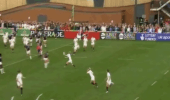 0:27
0:27
Women's - Counter attack plays 1
Women's - Counter attack plays
Back Row Attack Support
Back Row Attack Support
Continuity in Attack - Diamond Practice
The diamond practice can be the break out session of a whole part whole approach.
It is common when running such a practice for the attacking players to arrive at the tackle line having caught each other up. Depth should be maintained in order for the diamond shape to be fully effective.
The initial ball carrier needs to use footwork to move and disrtupt the defensive shape
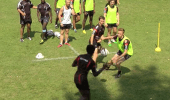 5:59
5:59
Quins - Creating Space & attacking lines
This clip shows the principles of fixing defenders and the techniques used to do so. The coach can progress by using more defenders, varying the space or changing the source of where the ball comes from
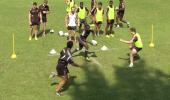 6:17
6:17
Quins - Attacking lines of support
Harlequins academy players are coached to be accurate in their passing and use lines of running and footwork to create space for other players
8. Attacking a Drift Defence
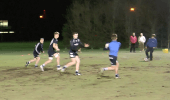 2:42
2:42
Attacking Options
Whether you're looking at fundamentals or strategy, we have loads of great examples and advice. Here's a small sample.
QBE - Back Line Attack From Set Piece
QBE - Attacking a Condensed Defence
 2:21
2:21
An Attacking Style
Consistency throughout a team can be very important for its success. You can have several very talented players, but if they are all taking a different approach to the game, they are not likely to be successful. Top teams will determine their style of rugby and find the right players to play to that style.


